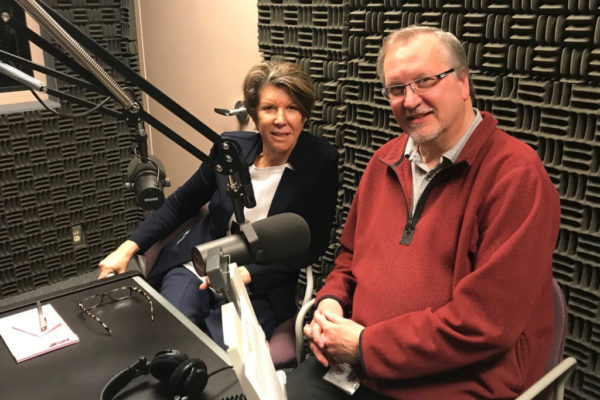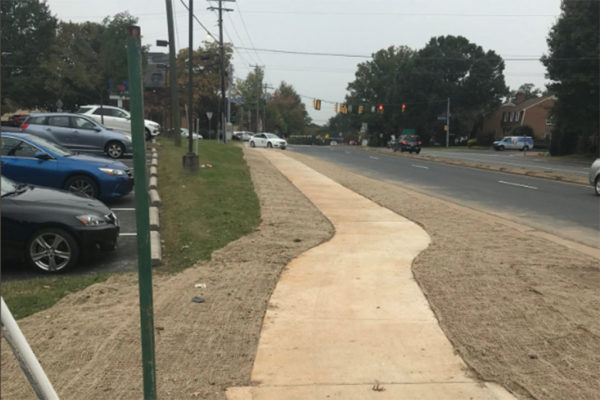If Tysons is going to become a destination, it’s going to need an Eiffel Tower — and slower, more pedestrian-friendly streets.
On the “Connect with County Leaders” podcast run by the Fairfax County Government, Deputy County Executive Rachel Flynn talked about the increasing importance of establishing a “destination” feeling with urban design to draw in a younger crowd.
“Millennials are deciding where they want to live before they get the job, then they move there and get the job,” Flynn said. “That’s the sign of a robust economy. So what can Fairfax do to say ‘we attracted that person?’ We don’t have an Eiffel Tower or a Chrysler building, but I think Tysons is the start of that.”
On its quest to become America’s next great city, Flynn said the area will have to be notable for something — presumably other than the historic Toilet Bowl building. Flynn referenced the example of San Francisco, noting that icons like the Golden Gate Bridge come to mind before any other details about the city.
But the other side of the coin to draw businesses and residents to Tysons, Flynn said, will be making the streets more walkable.
“We’re hearing that people want to walk more,” Flynn said. “They don’t want to be as car-dependent.”
But sometimes, Flynn noted, good pedestrian design can come at the cost of car-focused improvements, like more turn lanes. While Fairfax County has traditionally been built on its highways, Flynn said Tysons is going to need to continue switching to a more urban style street grid — specifically referencing Old Town Alexandria as a model for pedestrian-friendly design.
“Every time you add an extra right turn lane, someone is paying for that,” Flynn said. “Someone has to maintain that… and you just made a wider intersection for a pedestrian or cyclist, so maybe they don’t cross that street… Pedestrians know where they’re wanted, and that’s where they want to stay. So we need to slow down traffic and get more people out of their cars.”
For Tysons, Flynn said people should expect narrower lanes and slower traffic than they’d find in other parts of the county. Slower traffic, Flynn said, will not only add to pedestrian friendliness but will make retailers more likely to set up shop nearby.
“People are really drawn to a sense of place, that’s why Mosaic has been such a big hit and Tysons is becoming that way,” Flynn said. “People want to be at a place that feels good you have lots of choices of what to do.”
Photo via Fairfax County Government
Last week, Tysons Reporter examined the importance of sidewalk design as Tysons expands its pedestrian infrastructure network.
But no matter how well-designed a sidewalk might be, what matters most is that it’s in the right place.
There are three guidelines that Tysons can follow to make its pedestrian infrastructure more complete. The first is simply to find where people are already walking. The second is to connect sidewalks to public transit. The third is to provide cut-throughs in large blocks, connecting up the network.
Find the demand
An old architecture-school anecdote mentions a designer who was hired to lay out paths across a new college campus.
For the first months of the year, she left the entire campus unpaved, and students walked across the grass to their classes.
After the first snowfall, she took pictures of the quad from the bell tower, and then laid out the paths wherever she saw footprints in the snow.
In just the same way, dead grass and bootprints in Tysons reveals pedestrian activity. These are called “desire paths.”
They’re useful for transportation planners because they can prove, no speculation needed, that there really is demand for a sidewalk in a particular place. Even Tysons Plaza, connecting the mall to the Metro station, shows desire paths.
Desire paths can easily be paved over by the owner of the land, whether that is Fairfax County, the Virginia Department of Transportation, or a private interest. According to VDOT’s Project Cost Estimating System, a sidewalk costs only $25.15 per linear foot to install in Northern Virginia — it’s hard to think of a more affordable investment in transportation.
You can find desire paths all over Tysons at the ground level, especially near transit stations — which leads us to the next guideline.
Follow the transit
Public transportation and walkability have a symbiotic relationship. Unlike cars, buses and trains rarely drop passengers off right at their destination, meaning that they generally have to walk the final fraction of a mile. But in Tysons, that final stroll can be made circuitous, dangerous or uncomfortable by poor or disconnected pedestrian infrastructure.
As Jeff Speck, author of Walkable City, puts it: “while walkability benefits from good transit, good transit relies absolutely on walkability.” Since its opening in 2014, Silver Line ridership has been less than half of what was anticipated — perhaps because of Tysons’ slower-than-expected transformation into the kind of walkable area promised by ongoing development.
Pedestrian infrastructure is just as important to buses as it is to trains, particularly when a large number of bus stops in Tysons — like one pictured above — are located at neither crosswalks nor sidewalks. Crosswalks, including those in the middle of blocks, are essential to safety; according to VDOT, 51 percent of pedestrian injury crashes occurred at mid-block crossing locations and 86 percent of pedestrian fatal crashes occurred at locations without a marked crosswalk.
Mid-block crossings aren’t new to Fairfax, and they’re approved by VDOT and encouraged by the National Association of City Transportation Officials.
Connect the network
There are two main things that can get in the way of someone walking in Tysons, and they both tend to be larger here than in America’s older cities: streets and buildings.
The single block containing Tysons Corner Center measures almost half a mile, equivalent to about half a dozen blocks of downtown D.C. To walk around Tysons’ ‘superblocks’ is a long journey, but if paths are carved through them, these paths multiply the number of five- or ten-minute trips available to pedestrians.
Similarly, bridges and crosswalks also function as multipliers by connecting sidewalk networks. When a pedestrian bridge connected the Towers Crescent office building to Tysons Corner Center, it not only meant that 3,000 employees could walk to a variety of food options for their lunch hour, taking their cars off the road, it connected them to an expanding network of comfortable pedestrian infrastructure reaching beyond the Metro station.
A successful project
When sidewalks opened last month along Leesburg Pike under the Chain Bridge Road overpass, the project was successful because it observed all three of these guidelines.
First, there was demand. As one reader, Ryan, observed in the comments section, “Commuters were walking in the street for a few years, before we had this new sidewalk.”
Second, it was near transit, adjacent to the Greensboro Metro station.
Third, it provided a link between two previously-disconnected sidewalks, meaning that it didn’t only add pedestrian potential but multiplied it.
More and more sidewalks are coming to Tysons, but not all of them are created equal.
Sidewalks have been getting a lot of attention lately, They’re credited with the power to revitalize the economy and save lives, but sidewalks, like all infrastructure, need planning, engineering and investment — and some are implemented better than others.
Modern designers understand the subtleties of how to make a sidewalk safe and comfortable, while exciting new materials offer new technological possibilities and economists are coming to better understand the investment potential of sidewalks.
The best tools in any arsenal are multitaskers, and sidewalks aren’t just for moving. Just like we use streets for both driving and parking, we use sidewalks both for walking to a destination and also for standing still once we arrive.
In dense residential areas, like The Boro or The Mile, sidewalks can provide an outdoor common space, like a shared living room, for those living in small apartments. Sidewalks are also a good investment — they contribute thousands of dollars to property values. Good sidewalk design can even make a street safer for drivers.
Anatomy of a Sidewalk
The National Association of City Transportation Officials has a lot to say about how to engineer sidewalk space. In its design guide, it carves sidewalks up into three parallel zones – and while all three are for people, only one is actually about walking.
The frontage zone meets the facades of buildings and functions as an extension of them. It is usually home to cafe seating, benches, signs, staircases and entry ramps, and in residential areas individuals’ front gardens.
It can provide small nooks where you can stand under an awning and fire off a text message, or a place for eager customers to wait in line at the hip new cupcake shop. The frontage zone, while public, feels most closely associated with the building it touches.
The through zone is where pedestrians actually travel. It’s a clear lane for foot traffic, extending straight across multiple blocks, free of obstructions and wide enough for wheelchair users or groups of walkers to pass one another. It is often distinguished from the other two zones by a slightly different paving material. In order for pedestrians to move quickly, comfortably and efficiently, the through zone must be wide (at least five feet and up to 12) and unobstructed.
The furniture zone, also called the curb zone, is both the access to and the barrier from the street.
Traditionally, it is home to trees, light posts, traffic signs, utility boxes, newspaper stands and bus stops. In the 21st century, it gives us access to our wealth of new mobility options: car rental kiosks, Capital Bikeshare stations, pick-up zones for Uber or Lyft. This is where shared scooters ought to be parked.
Like the frontage zone, it can have benches or picnic tables, but this space feels entirely public, whereas benches in the frontage zone seem to belong to the adjacent building. The objects, furniture, and especially trees in this zone protect pedestrians from car traffic but the bus stops, taxi stands and bikeshare stations let them enter it on their terms. Like the wall of your house with its doors and windows, it protects you from the elements while also forming a point of access.
All sidewalks have these three zones, although they might blur together or be very narrow. Designing a good sidewalk, though, means understanding the role of each. Many sidewalks in Tysons, for lack in investment, don’t have the essential elements that fully flesh out the frontage and furniture zones. These sidewalks, simple concrete paths through grass, are incomplete.
Sidewalk Engineering
Concrete is classic, but new materials offer exciting possibilities for the sidewalks of the future. New kinds of sidewalks could double as automatic storm drains, use recycled materials, or generate electricity — and the D.C. area is on the cutting edge.
Engineers in many cities around the world have started experimenting with using recycled rubber as a paving material for the last two decades. Results have been mixed, with maintenance costs higher than expected in some places, but the rubber has a threefold advantage. DC has been a national leader with this technology, meaning Tysons has a lot of local expertise to reference.
First, by reusing waste rubber, the material is ecologically friendly.
Second, this rubber paving is usually slightly porous — meaning it absorbs some water during a heavy rainfall, helping deal with the thorny problem of stormwater management and preventing puddles from accumulating.
Third, as trees on sidewalks grow, their roots can push up and out, dislodging cement blocks and making the through zone inaccessible to those in wheelchairs. Rubber paving, because of its flexibility, can actually accommodate shifts in root structures without cracking.
Another new type of sidewalk has only made its way out of the laboratory a few years ago. In 2013, the George Washington University campus in next-door Loudoun County unveiled the world’s first walkable solar-powered pavement. This “Solar Walk,” part of the public campus sidewalk, uses solar panels embedded beneath a reinforced material to generate electricity that can not only light the sidewalk up at night but also send some power back to nearby Innovation Hall.
However, these flashy technologies have their critics, and it may be that traditional bricks offer greater value and some of the same benefits as the rubber material.
As local leaders work to make Tysons more walkable, a big part of that push is going to involve keeping the sidewalks clear during snowstorms.
One day after the first snowstorm of 2019, Tysons seem to have mostly — but not entirely — met that goal.
While most of the roads are cleared by the Virginia Department of Transportation, Robin Geiger, head of communications for the Fairfax County Department of Transportation, says private organizations and individuals around Tysons are entirely to credit for the clear sidewalks.
“Neither VDOT nor the county clears snow and ice from public walkways (sidewalks and most trails),” Geiger wrote. “While not legally obligated, residents and businesses are asked to help keep sidewalks safe, when possible, by clearing snow off the sidewalks in front of their property so that all pedestrians, especially school children, those with disabilities and the elderly, may walk securely.”
“Homeowner associations may require members of their communities to clear the private walkways abutting their property,” she added.
According to Geiger, the only sidewalks cleared by the county are those outside county-operated facilities, like police stations, fire stations, libraries and community centers.
By early afternoon yesterday (Monday), many of the sidewalks near Tysons Corner Center and Tysons Galleria were mostly or entirely cleared of snow. Undaunted by the cold, there were also a fair number of people taking advantage of the snow day to shop at both malls and other surrounding businesses.
Many of the outlying streets, like Jones Branch Drive, also had sidewalks on at least one side of the road clear, with some of the streets near residential developments remaining snow-covered. For many of the sidewalks on the fringes of Tysons, even those with a path through the snow are still covered with ice.
Geiger said if sidewalks in front of private property are not cleared by the owners or other private entities, the job falls upon Mother Nature.
“Many businesses, [homeowners associations], and residents clear sidewalks, but they are not required to by county ordinance,” said Geiger. “Some sidewalks do not get cleared during snow events.”
In Fairfax City, Falls Church, Alexandria and Arlington, ordinances do require business owners and residents to clear their sidewalks.
McLean may not be as fully walkable as residents would like, but one stretch of road is stepping in the right direction.
According to a Twitter post by District Supervisor John Foust, construction finished last week on a new sidewalk along Dolly Madison Highway (Route 123) near downtown McLean.
Did you notice the construction along 123 near downtown #McLean? @fairfaxcounty just installed new sidewalk to complete an important missing link & provide safer pedestrian access to bus stop near Kurtz Rd. Coming soon ➡ filling the gaps along 123 between Old Dominion & Beverly. pic.twitter.com/hmmo4MznQ1
— John Foust (@johnfoustva) October 26, 2018
The sidewalk construction is part of a broader effort to install new walkways across McLean.
Foust said the new sidewalks are part of an effort to complete a missing link and provide safer pedestrian access to the bus stop near Kurtz Road.
According to Foust, the construction will continue with new sidewalks on Dolly Madison Highway between Old Dominion. A Sept. 25 update on transportation projects estimated the Kurtz Road area sidewalks to be fully completed next spring and cost $450,000.
Additional sidewalks further along Dolly Madison Boulevard will be completed later that summer, also costing $450,000.
Photo via Twitter
 Drivers are being asked to pay extra attention on the roads tomorrow (Wednesday) morning as Fairfax County Public Schools participate in the annual International Walk to School Day.
Drivers are being asked to pay extra attention on the roads tomorrow (Wednesday) morning as Fairfax County Public Schools participate in the annual International Walk to School Day.
The event is “an effort to promote physical activity and reduce traffic congestion and pollution near schools.”
“Students and employees are encouraged to bike or walk to school and work on October 10,” FCPS said in a press release. “Parents are encouraged to accompany their children to school, and to work with their school and PTA or PTO to assemble bike trains or walking groups for the event.”
“FCPS has compiled information on walking and biking to school, including information on applying for grants and safety tips, on its Safe Routes to School web page,” the press release adds.
The elementary schools participating in International Walk to School Day in the Tysons, McLean, Vienna and Falls Church areas include:
- Chesterbrook
- Churchill Road
- Colvin Run
- Cunningham Park
- Fairhill
- Haycock
- Kent Gardens
- Marshall Road
- Spring Hill
- Vienna
- Westgate



